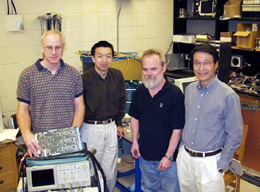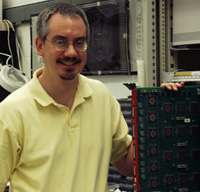 |
|
Making Connections University of Cincinnati and Ohio State University build on their research profiles at Fermilab by Sena Desai
A group of University of Cincinnati physicists braved the freezing Illinois winter of 2001 testing mineral oils for the 40-foot tall MiniBooNE detector at Fermilab.They found the right oil and the MiniBooNE experiment took off without a hitch. Almost 400 miles away, in the Ohio State University physics department, a group of faculty members and students built part of an electronic device called the extremely fast tracker (XFT)for Run II at the CDF detector.The XFT was assembled ahead of schedule at Fermilab and the experiment proceeded flawlessly. “Ohio has produced a lot of good physicists,” says Janet Conrad of Columbia University, cospokesperson for the MiniBooNE experiment. She has a theory about the relationship between Ohio and physicists.“There is no more than two degrees of separation between the state of Ohio and any physicist,”she laughs.“Almost all physicists have some connection to the state of Ohio.” Bill Reay led Fermilab experiments for Ohio State in the 1970s and 1980s before moving to the University of Kansas. Ohio State expanded its physics department in 1996 and intensified its Fermilab involvement. Grad student Chris Neu of CDF says up-and-coming physics programs benefit greatly from using a facility like Fermilab.“Ohio State University is increasing in stature because there are world-class facilities like [Fermilab ] that it can send its students to,”he says. The long-term benefits of this university-laboratory connection are clear. As Congressman Rob Portman,the Representative for the Second Congressional District of Ohio,which includes the University of Cincinnati, says,“The involvement of the University of Cincinnati’s physics program with Fermilab’s high-energy physics experiments benefits both institutions. A vital part of the university’s program is its relationship with Fermilab,where the university’s faculty and students participate in research with the best minds in the nation and the world. This interaction is particularly important in the creation of the next generation of scientists in Ohio.” Physicists, especially students, working at Fermilab gain from being surrounded by senior, experienced researchers.“It is easier working here amongst physicists,” says Jen Raaf,a University of Cincinnati graduate student working on the MiniBooNE experiment.“If I don’t understand something all I have to do is walk down the hallway and say,‘I don’t understand this.’ And five people will come out and explain things to me.” The University of Cincinnati began working with Fermilab in the early 1980s.But Randy Johnson, a professor in the university ’s physics department, had first come to Fermilab to do his thesis work while he was a University of California,Berkeley, graduate student in the early 1970s.At the time, the high-rise was not built and all the administrative offices were in the Village. “Oh,boy,I came here a long time ago,”he chuckles. Twelve years later,in 1984,he was hired as a faculty member by the University of Cincinnati and came back to work at Fermilab on the Neutrinos at the Tevatron (NuTev)experiment.“I have seen the laboratory grow,”he says.“I have seen a complete cycle of people at Fermilab.The laboratory just keeps rejuvenating.” The Fermilab-University of Cincinnati relationship grew even stronger when Johnson’s group joined the MiniBooNE experiment. In 1996,Fermilab researchers launched new plans to study neutrinos —those tiny, ghost-like particles —and began designing the MiniBooNE experiment.
Johnson’s group took on the task of finding the right mineral oil for the MiniBooNE detector, a 40-foot ball-shaped tank lined with large photosensors looking inward onto the oil.The neutrinos collide with mineral oil molecules, creating electrons,muons and other particles that emit a cone of blue light called Cerenkov light. The oil must transmit at least 90 percent of the emitted blue light, enabling the photosensors to record the light patterns that are distinct for each particle.Johnson, Raaf, and post-doc Eric Hawker tested different oils looking for the one with the desired optical properties. Conrad says Raaf actually learned to categorize oils by their fragrance.“She could make a fortune in the perfume industry,”laughs Conrad.Once the selection was made,the detector was filled and work began in May 2002. Raaf and Hawker then moved onto analysis.Raaf measures the rate at which the neutral pi-zero (Π°) particle is produced — a critical factor in screening out background.MiniBooNE searches for oscilla- tions of muon neutrinos.If one of the photons from the pi-zero decays has very little energy,that event may be mistakenly identified as an electron signal, stemming from an electron neutrino.Hawker helped compile literature for analyzing neutrino cross-sections —measuring the probability that neutrinos will interact in specific ways.“Neutrino experiments need this information,and the MiniBooNE group has become popular among neutrino experimenters because of this,”says Conrad. The University of Cincinnati’s Alan Schwartz, Michael Sokoloff,and Brian Meadows studied charm quarks at E791,a hadro-production experiment that collected data in the 1991-92 fixed target run.The experiment reconstructed the world’s largest sample,at the time,of charm decays,and used this sample to study a variety of charm production and decay properties.In the last two years the group has worked on the appearance of two light spinless particles,sigma and kappa,which have generated much interest from physicists around the world. Like Randy Johnson and Fermilab,the relationship between Ohio State University faculty and Fermilab also goes back a long way.Physics faculty from Ohio State University, Richard Hughes and Brian Winer,first worked at Fermilab when they were graduate students from other universities. They were later hired by Ohio State’s physics department and returned to Fermilab with their own graduate students,bringing the relationship full circle.
Hughes’interest in physics had actually stemmed from an earlier visit to Fermilab. As an electrical engineering undergraduate at the University of Pennsylvania,he had visited Fermilab and been drawn to the electronics of the CDF detector.He went on to study physics at the graduate level, hoping one day to build electronics for physics experiments.He worked at CDF as a University of Pennsylvania graduate student and later as a University of Rochester postdoc. Winer,too,had worked at CDF as a University of California-Berkeley graduate student,and later as a University of Rochester postdoc.He played a role in the discovery of the top quark at Fermilab in 1995,and “I was excited about research on the particle in the future,”he says. With Ohio State’s involvement in Fermilab research in 1996, Winer got his chance to study the top quark further.The university’s physics department hired Winer and Hughes as assistant professors to take advantage of their Fermilab connections. Since Hughes and Winer had worked on CDF for over six years, they chose to continue working there.“We knew the people and liked the physics there,”says Winer.At the time,CDF was upgrading from Run I to Run II,Hughes finally got his chance to build the electronics that he had always wanted to build. “So far we had been involved only in analysis,and we wanted to play a role in the upgrading of the detector,”says Hughes. In 1997,Hughes and Winer,with two postdocs,six graduates and six undergraduates,began building the XFT designed to identify flight paths of charged particles created in the collisions of protons and anti-protons.These trajectories help researchers decide which 30 of the 2.5 million collisions per second are interesting enough to record.This is no small feat,considering the information from the XFT must incorporate input from thousands of channels every 396 nanoseconds,or 2.5 million times per second. Once the XFT was in place,Neu,a student of the Hughes-Winer group,started doing background work on the Higgs boson,a particle predicted by theory.Neu is developing software relying on neural networks,which would recognizes the signature of the Higgs boson in data samples. He is testing the software on Run I data,trying to perfect a technique for identifying the Higgs boson. The discovery of the Higgs boson,named after British physicist Peter Higgs,would help scientists understand how the Higgs field,analogous to an electromagnetic field,manifests itself in particles through the Higgs boson,accounting for their masses. However,the Hughes-Winer group says the Higgs is only part of the Run focus.“There is lots of interesting physics in Run II,”says Winer.In Run I, researchers had gathered just enough data to establish that the top quark existed.Now,in Run II, they wanted to collect larger samples for studying top quark’s properties.“We will be learning something new about this beast,”says Hughes. “Run II will shed a lot of light on the nature of top quark.We will be able to measure its mass with more precision,”says Neu.“We will be able to search for exotic,undiscovered production mechanisms for the top quark.”
CDF’s co-spokesperson Nigel Lockyer says the Ohio State group is small, but very focused and aggressive.“Every one of them is visible,” he says. “Their main contribution is the XFT that worked since day one,” says Michael Lindgren,head of CDF operations.“Neu is also working on the most [fascinating ]aspect of Run II –the Higgs boson.” Ohio State is also part of the US-CMS collaboration, building components for the Compact Muon Solenoid detector of the Large Hadron Collider at CERN,the European Particle Physics Laboratory in Geneva,Switzerland.The CMS detector will search for the Higgs boson and other particles not described in the standard model.A Higgs boson can decay into muons,and Ling ’s group is designing the electronics for a muon detector. The growing connections with Fermilab and the involvement of new students help address what Ohio State president Karen Holbrook described as the “quiet crisis ”in the declining numbers of young people preparing for careers in science and technology.In her remarks to the American Association for the Advancement of Science Colloquium on Science and Technology in Washington D.C.on April 10,2003,Holbrook said federal spending on research and development has dipped to its lowest level in 50 years as a percentage of the Gross Domestic Product. “Federal policy is the number one factor in establishing the research environment in the U.S.,”Holbrook stressed.“Investing in research and development keeps the U.S.safe,healthy, environmentally sound,and scientifically competitive.”
ON THE WEB:
|



